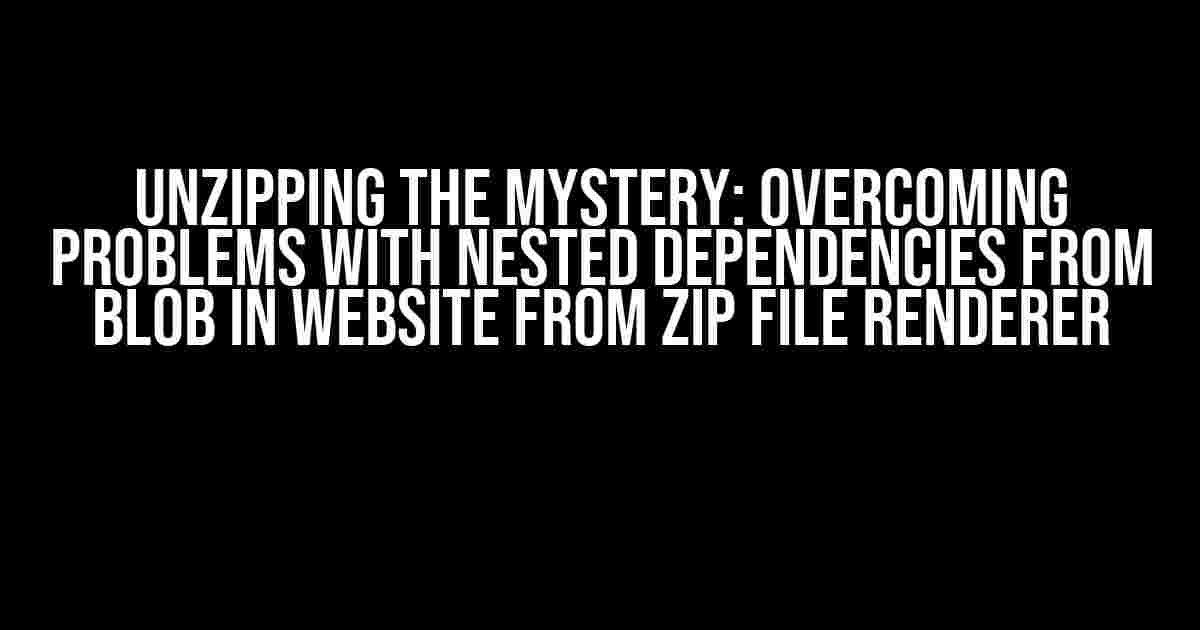Are you tired of wrestling with the pesky issues that arise when rendering a website from a zip file? Do nested dependencies from blob storage have you pulling your hair out? Fear not, dear developer, for we’re about to embark on a journey to tackle these problems head-on and emerge victorious!
Understanding the Problem: A Brief Overview
When you render a website from a zip file, the process can get quite complicated, especially when dealing with nested dependencies. These dependencies, often stored as blobs in cloud storage, can cause headaches when attempting to render them correctly. The main culprits behind these issues are:
- Zip file structure: The way you organize your files within the zip archive can greatly impact the rendering process.
- Blob storage limitations: Cloud storage services like AWS S3 or Azure Blob Storage have their own set of constraints when it comes to accessing and processing blob data.
- Nested dependency hierarchies: The complex relationships between dependencies can lead to rendering issues if not handled correctly.
Step-by-Step Guide to Overcoming Nested Dependencies from Blob
Now that we’ve identified the root causes of the problem, it’s time to delve into the solutions. Follow these steps to ensure a seamless website rendering experience:
Step 1: Organize Your Zip File Structure
A well-structured zip file is essential for a successful rendering process. Follow these best practices:
- Keep it flat: Avoid nesting folders excessively, as this can lead to rendering issues.
- Name it wisely: Use descriptive names for your files and folders to avoid confusion.
- Include a manifest file: A `manifest.json` file can help the renderer understand the zip file’s structure and dependencies.
Step 2: Configure Blob Storage for Optimal Retrieval
To efficiently retrieve blob data, consider the following:
- Use the correct content type: Ensure the content type of your blob matches the file type (e.g., `text/html` for HTML files).
- Set cache control headers: Configure cache control headers to optimize caching and reduce latency.
- Implement pagination: Divide large blob data into smaller, paginated chunks for efficient retrieval.
Step 3: Handle Nested Dependencies with Care
Nested dependencies can be a nightmare, but with the right approach, you can tame the beast:
- Use a dependency resolver: Implement a dependency resolver to manage complex relationships between dependencies.
- Flatten dependencies: Flatten nested dependencies into a single layer to simplify rendering.
- Use a manifest file: Leverage the `manifest.json` file to declare dependencies and their relationships.
Step 4: Implement a Robust Rendering Engine
A reliable rendering engine is crucial for a successful website rendering experience. Consider the following:
- Choose a robust engine: Select a rendering engine that can handle complex dependencies and blob storage.
- Configure the engine correctly: Properly configure the engine to handle nested dependencies and blob storage.
- Monitor and optimize performance: Continuously monitor and optimize the rendering engine’s performance.
Real-World Examples and Code Snippets
To help solidify these concepts, let’s take a look at some real-world examples and code snippets:
Example 1: Organizing a Zip File Structure
// Good zip file structure
my-website/
index.html
about/
about.html
images/
logo.png
styles/
style.css
manifest.json
Example 2: Configuring Blob Storage in AWS S3
// AWS S3 bucket configuration
AWS.config.update({
region: 'us-west-2',
accessKeyId: 'YOUR_ACCESS_KEY',
secretAccessKey: 'YOUR_SECRET_KEY',
});
const s3 = new AWS.S3({
params: {
Bucket: 'my-bucket',
},
});
// Set cache control headers
s3.putObject({
Bucket: 'my-bucket',
Key: 'index.html',
ContentType: 'text/html',
CacheControl: 'public, max-age=31536000',
}, (err, data) => {
if (err) console.log(err);
else console.log(data);
});
Example 3: Handling Nested Dependencies with a Dependency Resolver
// Dependency resolver module
const dependencies = require('./dependencies');
const dependencyResolver = (moduleName) => {
const dependency = dependencies[moduleName];
if (dependency) {
return dependency;
} else {
throw new Error(`Unknown dependency: ${moduleName}`);
}
};
// Example usage
const aboutModule = dependencyResolver('about');
aboutModule.render(); // Renders the about module correctly
Conclusion
Rendering a website from a zip file while dealing with nested dependencies from blob storage can be a complex task. However, by following the steps outlined in this article and using the provided examples and code snippets, you’ll be well on your way to overcoming these challenges. Remember to organize your zip file structure, configure blob storage for optimal retrieval, handle nested dependencies with care, and implement a robust rendering engine. With patience and practice, you’ll be rendering websites like a pro!
| Problem | Solution |
|---|---|
| Zip file structure issues | Keep it flat, name it wisely, and include a manifest file |
| Blob storage limitations | Use the correct content type, set cache control headers, and implement pagination |
| Nested dependencies | Use a dependency resolver, flatten dependencies, and use a manifest file |
| Rendering engine issues | Choose a robust engine, configure it correctly, and monitor and optimize performance |
Remember, the key to success lies in attention to detail and a deep understanding of the underlying concepts. Happy coding!
FAQs
Q: What if I have a large number of dependencies?
A: In that case, consider using a dependency manager like Webpack or Rollup to simplify the process.
Q: Can I use this approach for other file formats besides HTML?
A: Yes, this approach can be adapted for other file formats like JSON, CSS, or images, with some modifications to the rendering engine and blob storage configuration.
Q: How do I handle errors and debugging?
A: Implement robust error handling mechanisms, use logging and monitoring tools, and leverage debugging techniques like console logging or source maps to identify and fix issues.
Here are 5 Questions and Answers about “Website from zip file renderer – problems with nested dependencies from blob” in a creative tone:
Frequently Asked Question
Don’t let rendering website from a zip file renderer get you down! We’ve got the answers to your burning questions about those pesky nested dependencies from blob.
Why do I get errors when rendering a website from a zip file renderer?
Ah, the joys of rendering a website from a zip file! Errors can occur due to corrupted or incomplete zip files, incorrect file paths, or missing dependencies. Make sure to double-check your zip file’s integrity and specify correct file paths to avoid any hiccups!
What are nested dependencies, and why do they cause issues with the blob?
Nested dependencies refer to dependencies within dependencies – think Russian nesting dolls, but with code! These can cause issues with the blob because they might lead to circular dependencies or conflicts. Keep an eye out for overly complex dependency structures to avoid blob-related woes!
How do I troubleshoot issues with nested dependencies in my zip file?
When troubleshooting, start by identifying the problematic dependency and its nested friends. Then, try isolating the issue by testing individual dependencies or removing unnecessary ones. Don’t forget to check for version conflicts or outdated dependencies – a fresh update might just do the trick!
Can I prevent nested dependencies from causing issues with my website renderer?
Absolutely! To prevent nested dependency drama, keep your dependencies simple, organized, and up-to-date. Use dependency management tools to track and optimize your dependencies. And, of course, always test your zip file renderer before deploying your website to the world!
What are some best practices for creating a zip file renderer that handles nested dependencies efficiently?
When creating a zip file renderer, follow the golden rule: keep it simple, keep it clean! Use modular code, avoid circular dependencies, and opt for flexible, modular architecture. Don’t be afraid to ask for help, and always test, test, test – your website (and users) will thank you!






